Sustainable Operations: A Case Study on Coca-Cola's Initiatives
VerifiedAdded on 2023/06/14
|6
|1685
|315
Case Study
AI Summary
This case study examines Coca-Cola's sustainability initiatives, highlighting both proactive measures and shortcomings. While Coca-Cola emphasizes human rights and sustainability reporting, concerns arise regarding plastic pollution and recycling efforts. The company's commitment to increasing recycled plastic content is questioned, especially in light of past failures to meet sustainability goals. The case study contrasts Coca-Cola's performance with other companies and underscores the need for more decisive action and government intervention through deposit return schemes. Despite claims of prioritizing genuine advancements over marketing slogans, Coca-Cola's innovative packaging strategies are scrutinized for their effectiveness and impact on environmental sustainability. Desklib provides a platform for students to access similar case studies and solved assignments to aid in their academic pursuits.
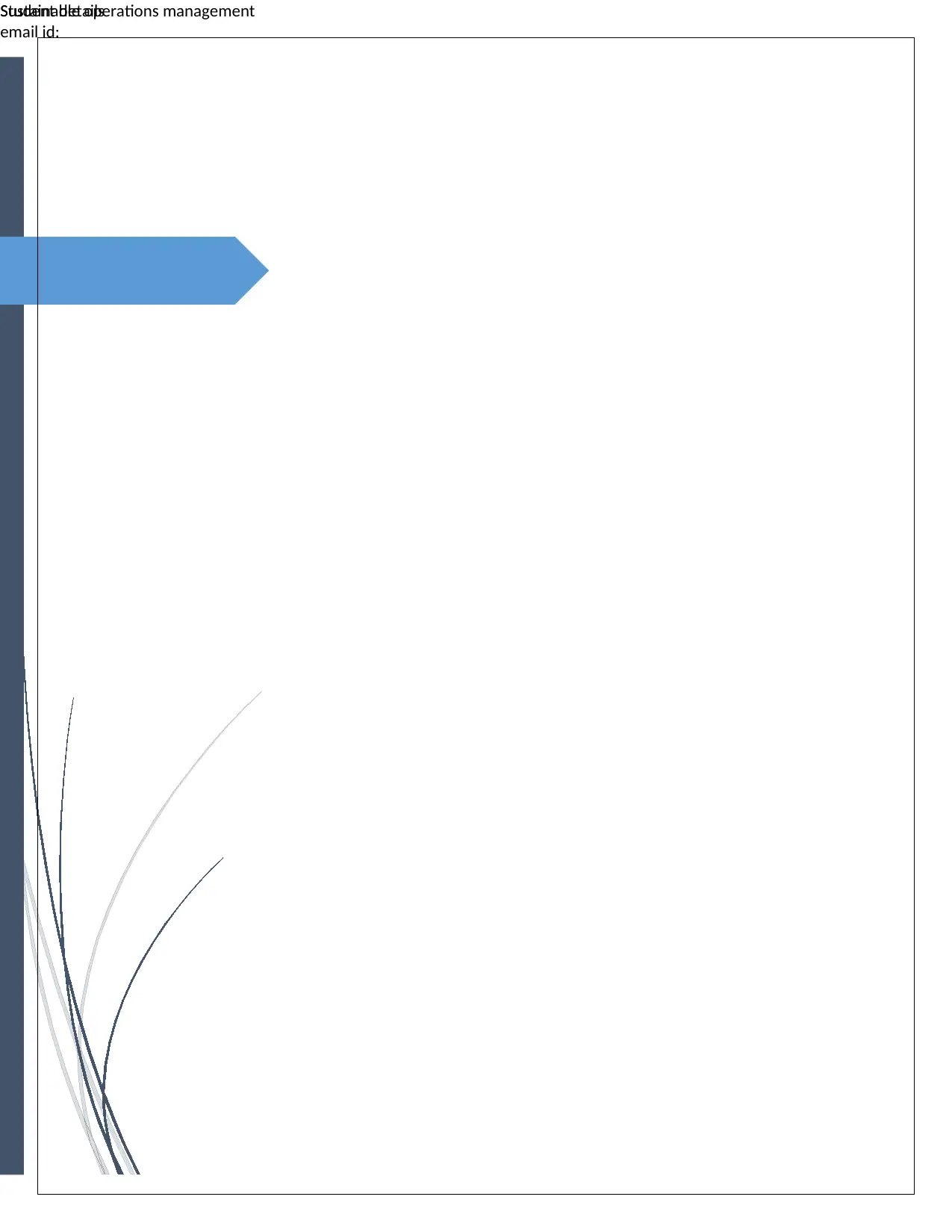
Sustainable operations managementStudent details
email id:
email id:
Paraphrase This Document
Need a fresh take? Get an instant paraphrase of this document with our AI Paraphraser
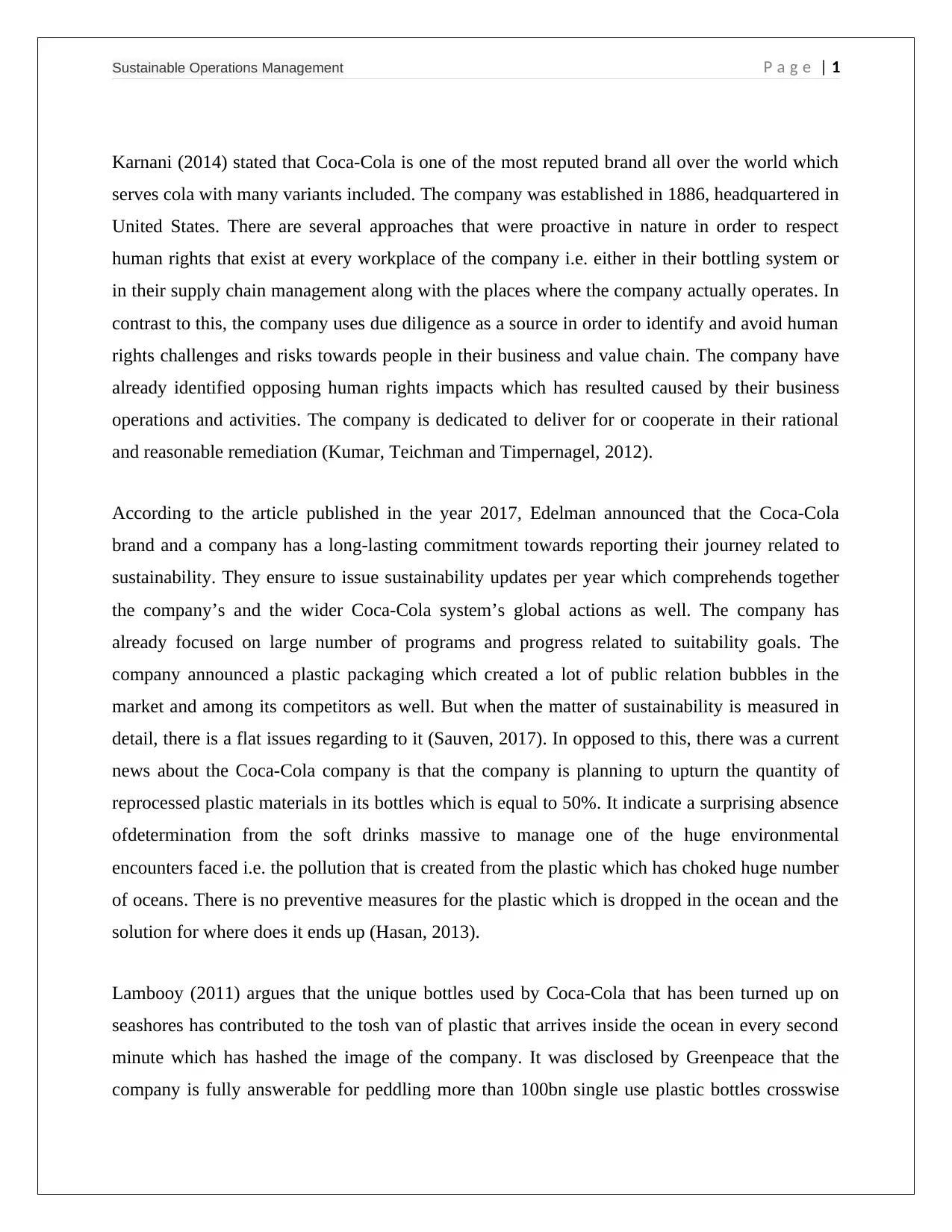
Sustainable Operations Management P a g e | 1
Karnani (2014) stated that Coca-Cola is one of the most reputed brand all over the world which
serves cola with many variants included. The company was established in 1886, headquartered in
United States. There are several approaches that were proactive in nature in order to respect
human rights that exist at every workplace of the company i.e. either in their bottling system or
in their supply chain management along with the places where the company actually operates. In
contrast to this, the company uses due diligence as a source in order to identify and avoid human
rights challenges and risks towards people in their business and value chain. The company have
already identified opposing human rights impacts which has resulted caused by their business
operations and activities. The company is dedicated to deliver for or cooperate in their rational
and reasonable remediation (Kumar, Teichman and Timpernagel, 2012).
According to the article published in the year 2017, Edelman announced that the Coca-Cola
brand and a company has a long-lasting commitment towards reporting their journey related to
sustainability. They ensure to issue sustainability updates per year which comprehends together
the company’s and the wider Coca-Cola system’s global actions as well. The company has
already focused on large number of programs and progress related to suitability goals. The
company announced a plastic packaging which created a lot of public relation bubbles in the
market and among its competitors as well. But when the matter of sustainability is measured in
detail, there is a flat issues regarding to it (Sauven, 2017). In opposed to this, there was a current
news about the Coca-Cola company is that the company is planning to upturn the quantity of
reprocessed plastic materials in its bottles which is equal to 50%. It indicate a surprising absence
ofdetermination from the soft drinks massive to manage one of the huge environmental
encounters faced i.e. the pollution that is created from the plastic which has choked huge number
of oceans. There is no preventive measures for the plastic which is dropped in the ocean and the
solution for where does it ends up (Hasan, 2013).
Lambooy (2011) argues that the unique bottles used by Coca-Cola that has been turned up on
seashores has contributed to the tosh van of plastic that arrives inside the ocean in every second
minute which has hashed the image of the company. It was disclosed by Greenpeace that the
company is fully answerable for peddling more than 100bn single use plastic bottles crosswise
Karnani (2014) stated that Coca-Cola is one of the most reputed brand all over the world which
serves cola with many variants included. The company was established in 1886, headquartered in
United States. There are several approaches that were proactive in nature in order to respect
human rights that exist at every workplace of the company i.e. either in their bottling system or
in their supply chain management along with the places where the company actually operates. In
contrast to this, the company uses due diligence as a source in order to identify and avoid human
rights challenges and risks towards people in their business and value chain. The company have
already identified opposing human rights impacts which has resulted caused by their business
operations and activities. The company is dedicated to deliver for or cooperate in their rational
and reasonable remediation (Kumar, Teichman and Timpernagel, 2012).
According to the article published in the year 2017, Edelman announced that the Coca-Cola
brand and a company has a long-lasting commitment towards reporting their journey related to
sustainability. They ensure to issue sustainability updates per year which comprehends together
the company’s and the wider Coca-Cola system’s global actions as well. The company has
already focused on large number of programs and progress related to suitability goals. The
company announced a plastic packaging which created a lot of public relation bubbles in the
market and among its competitors as well. But when the matter of sustainability is measured in
detail, there is a flat issues regarding to it (Sauven, 2017). In opposed to this, there was a current
news about the Coca-Cola company is that the company is planning to upturn the quantity of
reprocessed plastic materials in its bottles which is equal to 50%. It indicate a surprising absence
ofdetermination from the soft drinks massive to manage one of the huge environmental
encounters faced i.e. the pollution that is created from the plastic which has choked huge number
of oceans. There is no preventive measures for the plastic which is dropped in the ocean and the
solution for where does it ends up (Hasan, 2013).
Lambooy (2011) argues that the unique bottles used by Coca-Cola that has been turned up on
seashores has contributed to the tosh van of plastic that arrives inside the ocean in every second
minute which has hashed the image of the company. It was disclosed by Greenpeace that the
company is fully answerable for peddling more than 100bn single use plastic bottles crosswise
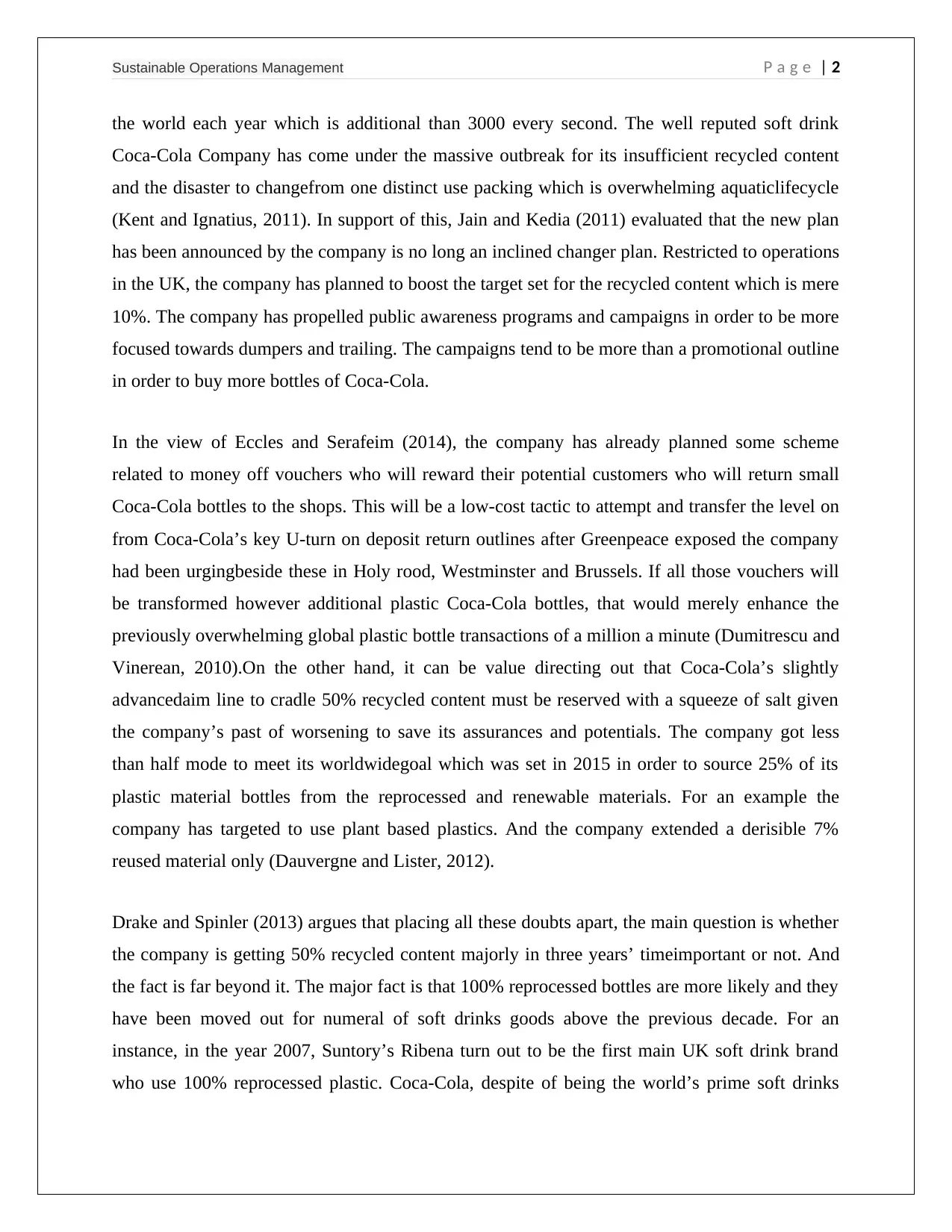
Sustainable Operations Management P a g e | 2
the world each year which is additional than 3000 every second. The well reputed soft drink
Coca-Cola Company has come under the massive outbreak for its insufficient recycled content
and the disaster to changefrom one distinct use packing which is overwhelming aquaticlifecycle
(Kent and Ignatius, 2011). In support of this, Jain and Kedia (2011) evaluated that the new plan
has been announced by the company is no long an inclined changer plan. Restricted to operations
in the UK, the company has planned to boost the target set for the recycled content which is mere
10%. The company has propelled public awareness programs and campaigns in order to be more
focused towards dumpers and trailing. The campaigns tend to be more than a promotional outline
in order to buy more bottles of Coca-Cola.
In the view of Eccles and Serafeim (2014), the company has already planned some scheme
related to money off vouchers who will reward their potential customers who will return small
Coca-Cola bottles to the shops. This will be a low-cost tactic to attempt and transfer the level on
from Coca-Cola’s key U-turn on deposit return outlines after Greenpeace exposed the company
had been urgingbeside these in Holy rood, Westminster and Brussels. If all those vouchers will
be transformed however additional plastic Coca-Cola bottles, that would merely enhance the
previously overwhelming global plastic bottle transactions of a million a minute (Dumitrescu and
Vinerean, 2010).On the other hand, it can be value directing out that Coca-Cola’s slightly
advancedaim line to cradle 50% recycled content must be reserved with a squeeze of salt given
the company’s past of worsening to save its assurances and potentials. The company got less
than half mode to meet its worldwidegoal which was set in 2015 in order to source 25% of its
plastic material bottles from the reprocessed and renewable materials. For an example the
company has targeted to use plant based plastics. And the company extended a derisible 7%
reused material only (Dauvergne and Lister, 2012).
Drake and Spinler (2013) argues that placing all these doubts apart, the main question is whether
the company is getting 50% recycled content majorly in three years’ timeimportant or not. And
the fact is far beyond it. The major fact is that 100% reprocessed bottles are more likely and they
have been moved out for numeral of soft drinks goods above the previous decade. For an
instance, in the year 2007, Suntory’s Ribena turn out to be the first main UK soft drink brand
who use 100% reprocessed plastic. Coca-Cola, despite of being the world’s prime soft drinks
the world each year which is additional than 3000 every second. The well reputed soft drink
Coca-Cola Company has come under the massive outbreak for its insufficient recycled content
and the disaster to changefrom one distinct use packing which is overwhelming aquaticlifecycle
(Kent and Ignatius, 2011). In support of this, Jain and Kedia (2011) evaluated that the new plan
has been announced by the company is no long an inclined changer plan. Restricted to operations
in the UK, the company has planned to boost the target set for the recycled content which is mere
10%. The company has propelled public awareness programs and campaigns in order to be more
focused towards dumpers and trailing. The campaigns tend to be more than a promotional outline
in order to buy more bottles of Coca-Cola.
In the view of Eccles and Serafeim (2014), the company has already planned some scheme
related to money off vouchers who will reward their potential customers who will return small
Coca-Cola bottles to the shops. This will be a low-cost tactic to attempt and transfer the level on
from Coca-Cola’s key U-turn on deposit return outlines after Greenpeace exposed the company
had been urgingbeside these in Holy rood, Westminster and Brussels. If all those vouchers will
be transformed however additional plastic Coca-Cola bottles, that would merely enhance the
previously overwhelming global plastic bottle transactions of a million a minute (Dumitrescu and
Vinerean, 2010).On the other hand, it can be value directing out that Coca-Cola’s slightly
advancedaim line to cradle 50% recycled content must be reserved with a squeeze of salt given
the company’s past of worsening to save its assurances and potentials. The company got less
than half mode to meet its worldwidegoal which was set in 2015 in order to source 25% of its
plastic material bottles from the reprocessed and renewable materials. For an example the
company has targeted to use plant based plastics. And the company extended a derisible 7%
reused material only (Dauvergne and Lister, 2012).
Drake and Spinler (2013) argues that placing all these doubts apart, the main question is whether
the company is getting 50% recycled content majorly in three years’ timeimportant or not. And
the fact is far beyond it. The major fact is that 100% reprocessed bottles are more likely and they
have been moved out for numeral of soft drinks goods above the previous decade. For an
instance, in the year 2007, Suntory’s Ribena turn out to be the first main UK soft drink brand
who use 100% reprocessed plastic. Coca-Cola, despite of being the world’s prime soft drinks
⊘ This is a preview!⊘
Do you want full access?
Subscribe today to unlock all pages.

Trusted by 1+ million students worldwide
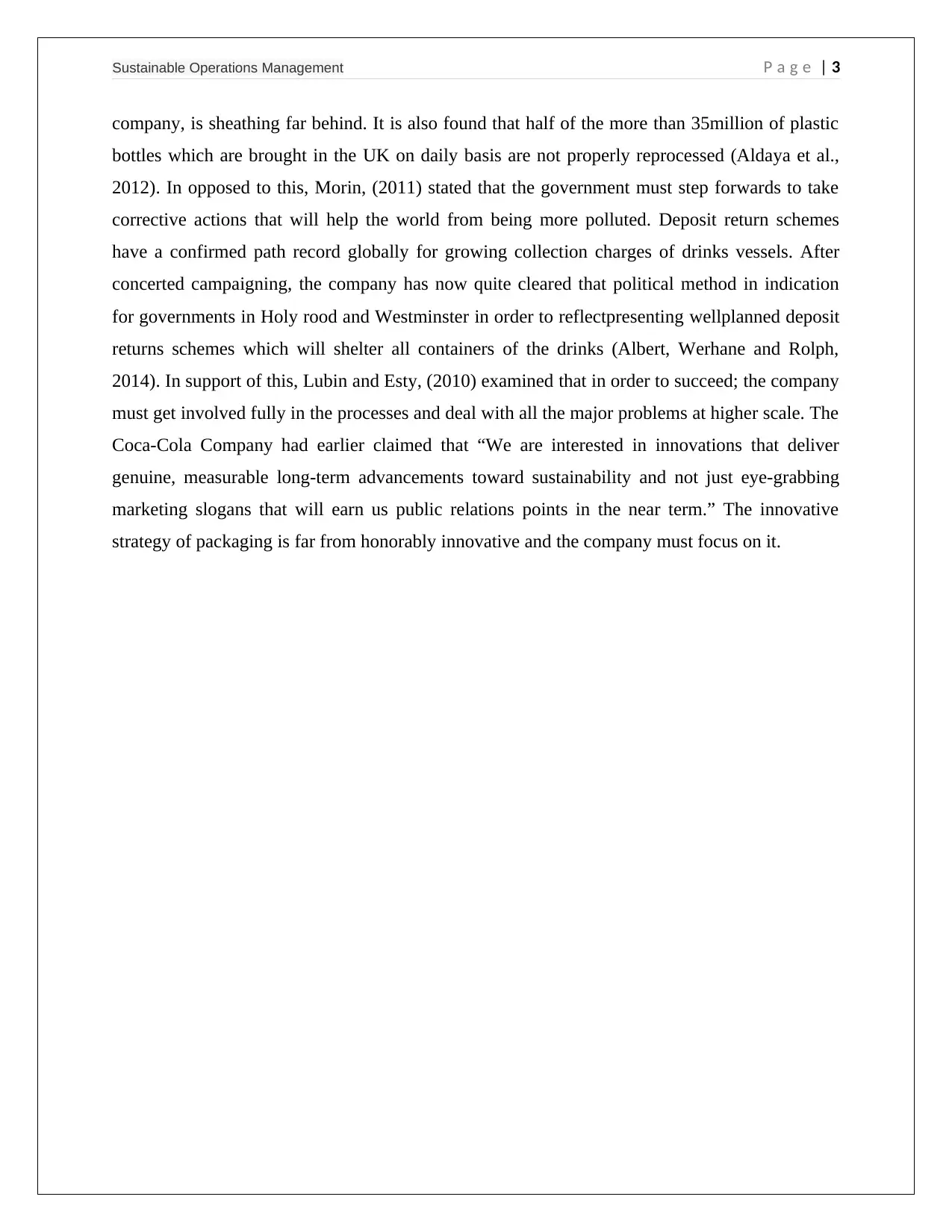
Sustainable Operations Management P a g e | 3
company, is sheathing far behind. It is also found that half of the more than 35million of plastic
bottles which are brought in the UK on daily basis are not properly reprocessed (Aldaya et al.,
2012). In opposed to this, Morin, (2011) stated that the government must step forwards to take
corrective actions that will help the world from being more polluted. Deposit return schemes
have a confirmed path record globally for growing collection charges of drinks vessels. After
concerted campaigning, the company has now quite cleared that political method in indication
for governments in Holy rood and Westminster in order to reflectpresenting wellplanned deposit
returns schemes which will shelter all containers of the drinks (Albert, Werhane and Rolph,
2014). In support of this, Lubin and Esty, (2010) examined that in order to succeed; the company
must get involved fully in the processes and deal with all the major problems at higher scale. The
Coca-Cola Company had earlier claimed that “We are interested in innovations that deliver
genuine, measurable long-term advancements toward sustainability and not just eye-grabbing
marketing slogans that will earn us public relations points in the near term.” The innovative
strategy of packaging is far from honorably innovative and the company must focus on it.
company, is sheathing far behind. It is also found that half of the more than 35million of plastic
bottles which are brought in the UK on daily basis are not properly reprocessed (Aldaya et al.,
2012). In opposed to this, Morin, (2011) stated that the government must step forwards to take
corrective actions that will help the world from being more polluted. Deposit return schemes
have a confirmed path record globally for growing collection charges of drinks vessels. After
concerted campaigning, the company has now quite cleared that political method in indication
for governments in Holy rood and Westminster in order to reflectpresenting wellplanned deposit
returns schemes which will shelter all containers of the drinks (Albert, Werhane and Rolph,
2014). In support of this, Lubin and Esty, (2010) examined that in order to succeed; the company
must get involved fully in the processes and deal with all the major problems at higher scale. The
Coca-Cola Company had earlier claimed that “We are interested in innovations that deliver
genuine, measurable long-term advancements toward sustainability and not just eye-grabbing
marketing slogans that will earn us public relations points in the near term.” The innovative
strategy of packaging is far from honorably innovative and the company must focus on it.
Paraphrase This Document
Need a fresh take? Get an instant paraphrase of this document with our AI Paraphraser
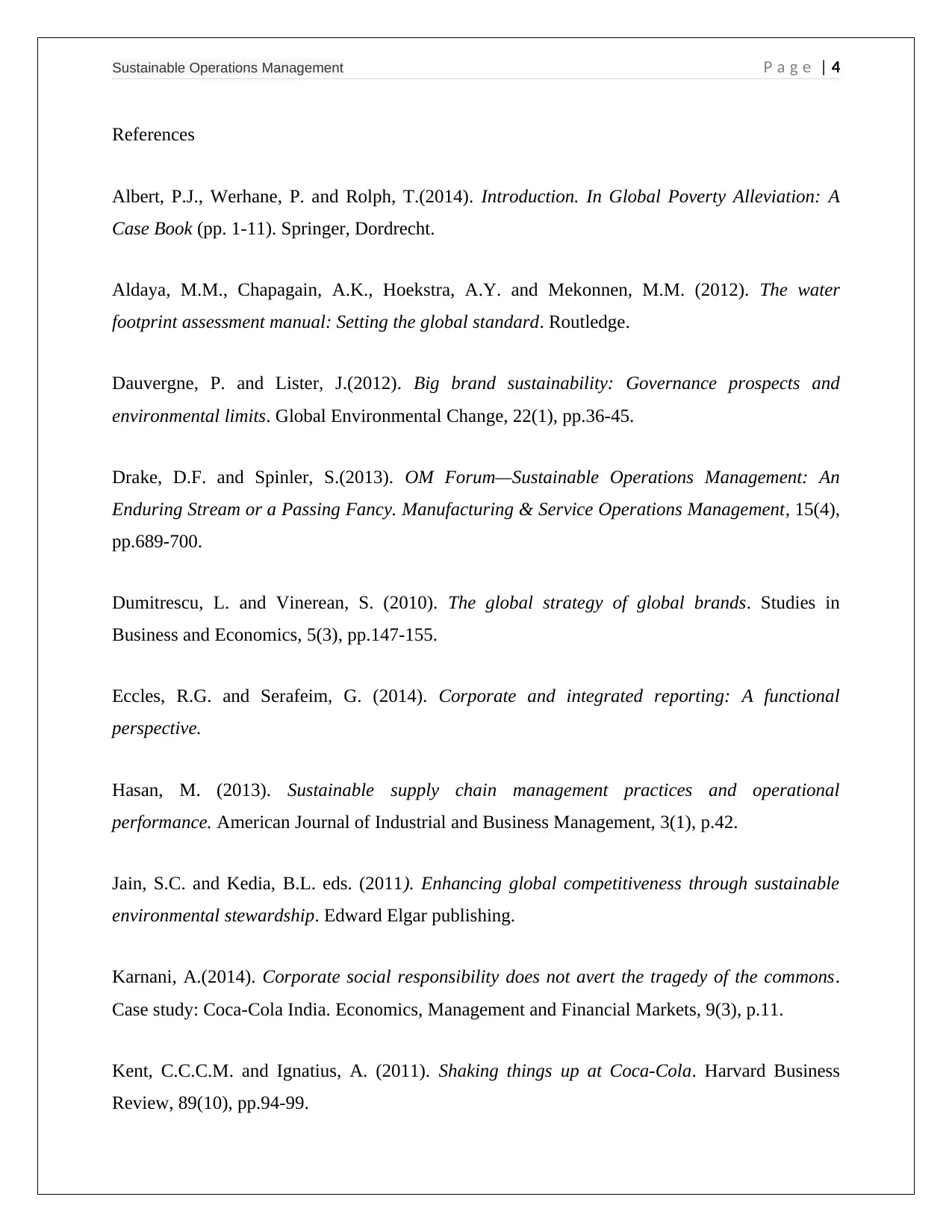
Sustainable Operations Management P a g e | 4
References
Albert, P.J., Werhane, P. and Rolph, T.(2014). Introduction. In Global Poverty Alleviation: A
Case Book (pp. 1-11). Springer, Dordrecht.
Aldaya, M.M., Chapagain, A.K., Hoekstra, A.Y. and Mekonnen, M.M. (2012). The water
footprint assessment manual: Setting the global standard. Routledge.
Dauvergne, P. and Lister, J.(2012). Big brand sustainability: Governance prospects and
environmental limits. Global Environmental Change, 22(1), pp.36-45.
Drake, D.F. and Spinler, S.(2013). OM Forum—Sustainable Operations Management: An
Enduring Stream or a Passing Fancy. Manufacturing & Service Operations Management, 15(4),
pp.689-700.
Dumitrescu, L. and Vinerean, S. (2010). The global strategy of global brands. Studies in
Business and Economics, 5(3), pp.147-155.
Eccles, R.G. and Serafeim, G. (2014). Corporate and integrated reporting: A functional
perspective.
Hasan, M. (2013). Sustainable supply chain management practices and operational
performance. American Journal of Industrial and Business Management, 3(1), p.42.
Jain, S.C. and Kedia, B.L. eds. (2011). Enhancing global competitiveness through sustainable
environmental stewardship. Edward Elgar publishing.
Karnani, A.(2014). Corporate social responsibility does not avert the tragedy of the commons.
Case study: Coca-Cola India. Economics, Management and Financial Markets, 9(3), p.11.
Kent, C.C.C.M. and Ignatius, A. (2011). Shaking things up at Coca-Cola. Harvard Business
Review, 89(10), pp.94-99.
References
Albert, P.J., Werhane, P. and Rolph, T.(2014). Introduction. In Global Poverty Alleviation: A
Case Book (pp. 1-11). Springer, Dordrecht.
Aldaya, M.M., Chapagain, A.K., Hoekstra, A.Y. and Mekonnen, M.M. (2012). The water
footprint assessment manual: Setting the global standard. Routledge.
Dauvergne, P. and Lister, J.(2012). Big brand sustainability: Governance prospects and
environmental limits. Global Environmental Change, 22(1), pp.36-45.
Drake, D.F. and Spinler, S.(2013). OM Forum—Sustainable Operations Management: An
Enduring Stream or a Passing Fancy. Manufacturing & Service Operations Management, 15(4),
pp.689-700.
Dumitrescu, L. and Vinerean, S. (2010). The global strategy of global brands. Studies in
Business and Economics, 5(3), pp.147-155.
Eccles, R.G. and Serafeim, G. (2014). Corporate and integrated reporting: A functional
perspective.
Hasan, M. (2013). Sustainable supply chain management practices and operational
performance. American Journal of Industrial and Business Management, 3(1), p.42.
Jain, S.C. and Kedia, B.L. eds. (2011). Enhancing global competitiveness through sustainable
environmental stewardship. Edward Elgar publishing.
Karnani, A.(2014). Corporate social responsibility does not avert the tragedy of the commons.
Case study: Coca-Cola India. Economics, Management and Financial Markets, 9(3), p.11.
Kent, C.C.C.M. and Ignatius, A. (2011). Shaking things up at Coca-Cola. Harvard Business
Review, 89(10), pp.94-99.
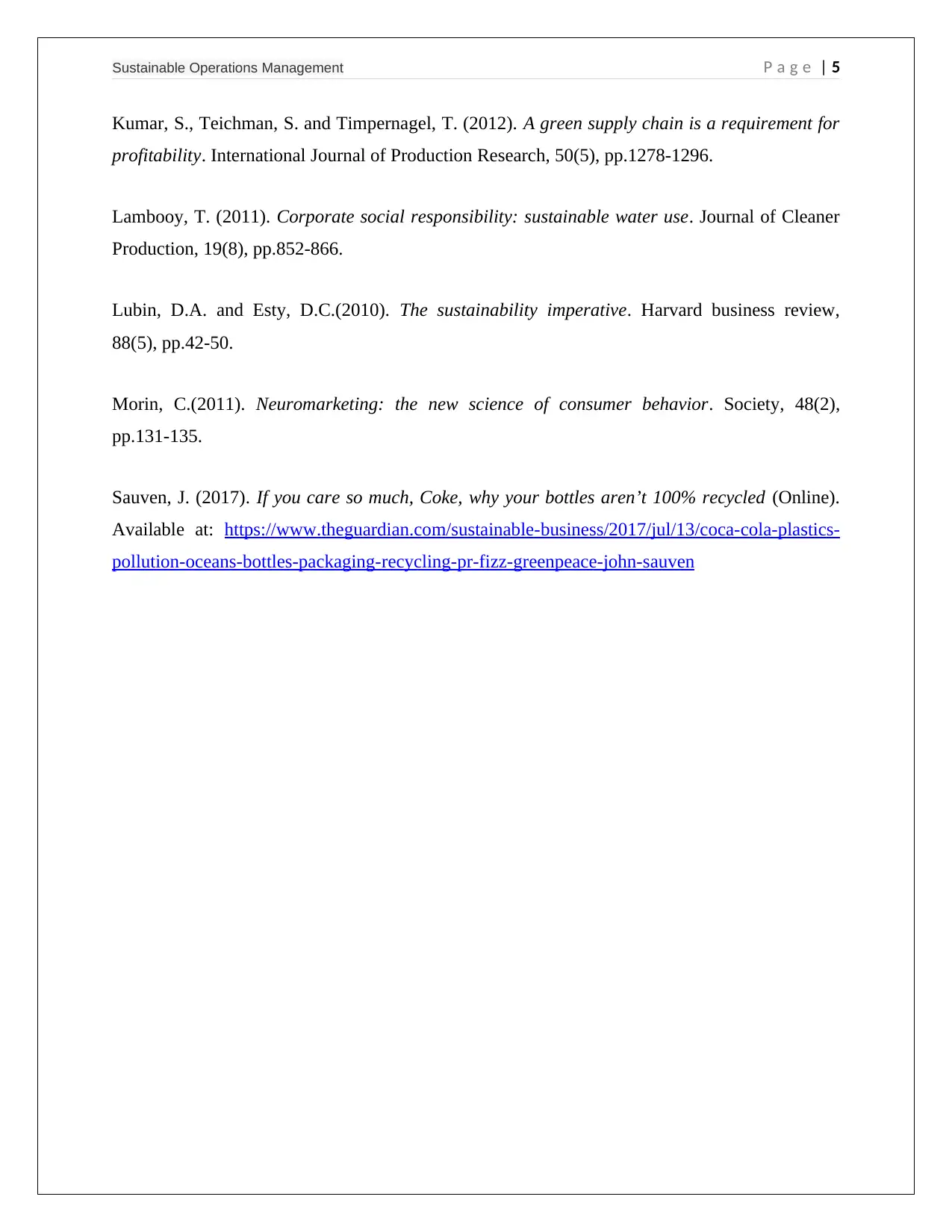
Sustainable Operations Management P a g e | 5
Kumar, S., Teichman, S. and Timpernagel, T. (2012). A green supply chain is a requirement for
profitability. International Journal of Production Research, 50(5), pp.1278-1296.
Lambooy, T. (2011). Corporate social responsibility: sustainable water use. Journal of Cleaner
Production, 19(8), pp.852-866.
Lubin, D.A. and Esty, D.C.(2010). The sustainability imperative. Harvard business review,
88(5), pp.42-50.
Morin, C.(2011). Neuromarketing: the new science of consumer behavior. Society, 48(2),
pp.131-135.
Sauven, J. (2017). If you care so much, Coke, why your bottles aren’t 100% recycled (Online).
Available at: https://www.theguardian.com/sustainable-business/2017/jul/13/coca-cola-plastics-
pollution-oceans-bottles-packaging-recycling-pr-fizz-greenpeace-john-sauven
Kumar, S., Teichman, S. and Timpernagel, T. (2012). A green supply chain is a requirement for
profitability. International Journal of Production Research, 50(5), pp.1278-1296.
Lambooy, T. (2011). Corporate social responsibility: sustainable water use. Journal of Cleaner
Production, 19(8), pp.852-866.
Lubin, D.A. and Esty, D.C.(2010). The sustainability imperative. Harvard business review,
88(5), pp.42-50.
Morin, C.(2011). Neuromarketing: the new science of consumer behavior. Society, 48(2),
pp.131-135.
Sauven, J. (2017). If you care so much, Coke, why your bottles aren’t 100% recycled (Online).
Available at: https://www.theguardian.com/sustainable-business/2017/jul/13/coca-cola-plastics-
pollution-oceans-bottles-packaging-recycling-pr-fizz-greenpeace-john-sauven
⊘ This is a preview!⊘
Do you want full access?
Subscribe today to unlock all pages.

Trusted by 1+ million students worldwide
1 out of 6
Related Documents
Your All-in-One AI-Powered Toolkit for Academic Success.
+13062052269
info@desklib.com
Available 24*7 on WhatsApp / Email
![[object Object]](/_next/static/media/star-bottom.7253800d.svg)
Unlock your academic potential
Copyright © 2020–2025 A2Z Services. All Rights Reserved. Developed and managed by ZUCOL.





